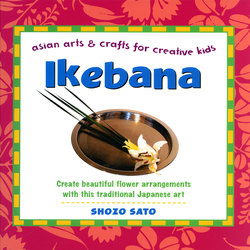Ikebana: Asian Arts and Crafts for Creative Kids

Реклама. ООО «ЛитРес», ИНН: 7719571260.
Оглавление
Shozo Sato. Ikebana: Asian Arts and Crafts for Creative Kids
Отрывок из книги
Today, television, CD players, and computer games take up a lot of our time, and though we can enjoy these forms of entertainment at home, we can't live without being in touch with the natural world. It is so important that we continue to find ways to experience and be a part of nature, especially when so much time can be spent away from it.
In the long history of Japan, there is an art form called ikebana that uses natural materials such as flowers and branches from trees to make beautiful arrangements and creations. Creating ikebana arrangements is a perfect way to experience nature and explore its beauty. Flowers have been an important part of culture throughout history: When a loved one passes away, flowers are usually offered; for happy occasions, flowers are presented to dear friends. These customs of expressing feelings through flowers can be found in any culture, and as you work through the projects in this book, you'll find that flowers really do help us to express our feelings of joy or sadness in many ways. As a Japanese descendant, I take great pleasure in sharing the art of ikebana with you. This book includes a simple history of ikebana and a brief explanation of the traditional styles of ikebana, and then you are invited to actually arrange flowers following the step-by-step lessons in making arrangements. I sincerely hope you will enjoy your own creations from these beautiful flowers. So go ahead and express your feelings of joy or sadness through the wonderful art of ikebana.
.....
Over the years, some of the dedicated Buddhist monks who arranged the offerings of flowers became experts in creating the overall design of the altars for various occasions. These talented Buddhist monks started to work outside of the temples and were hired by men of power who ruled the government to decorate their audience halls. Using today's equivalents, the monk's job was to be an art director—he would select the proper paintings and decorations and then create large flower arrangements for these audience and reception halls. Many of these artistically talented monks, with their great sense of judgment and sensitivity to various types of beauty, also became well known as black ink painters, calligraphers, and haiku poets. During those early days, the general category of professional artists did not exist.
The form of ikebana that the Buddhist monks created became known as rikka. Using their role as specialists in arranging flowers, the monks began to incorporate Buddhist teaching in their rikka arrangements, and tried to symbolically recreate the Buddhist nirvana, an idealized sacred land, within the arrangement itself.
.....